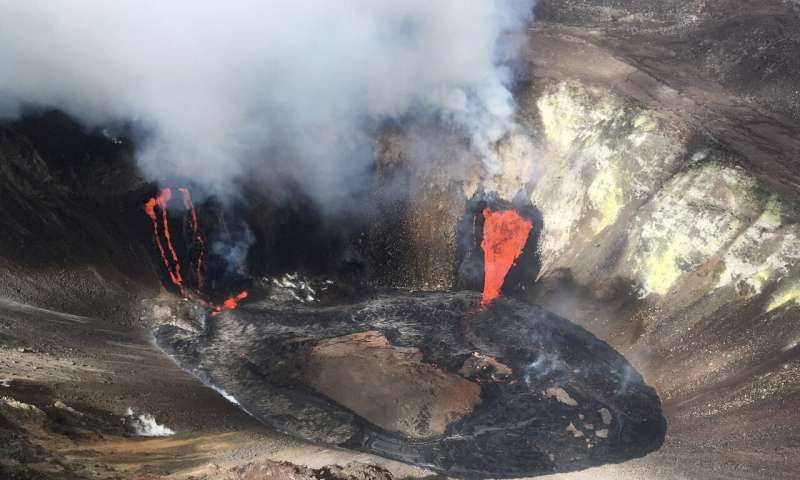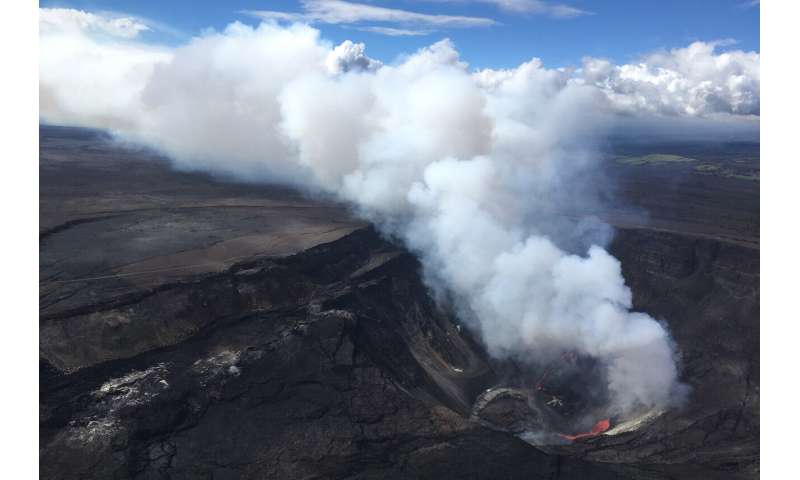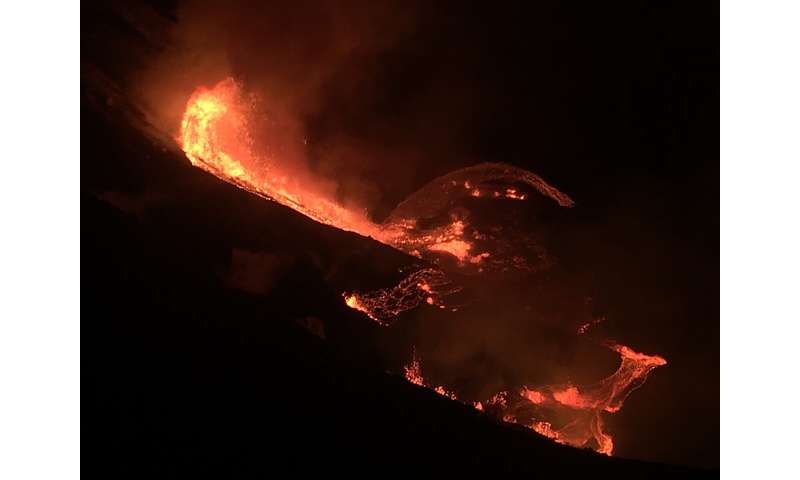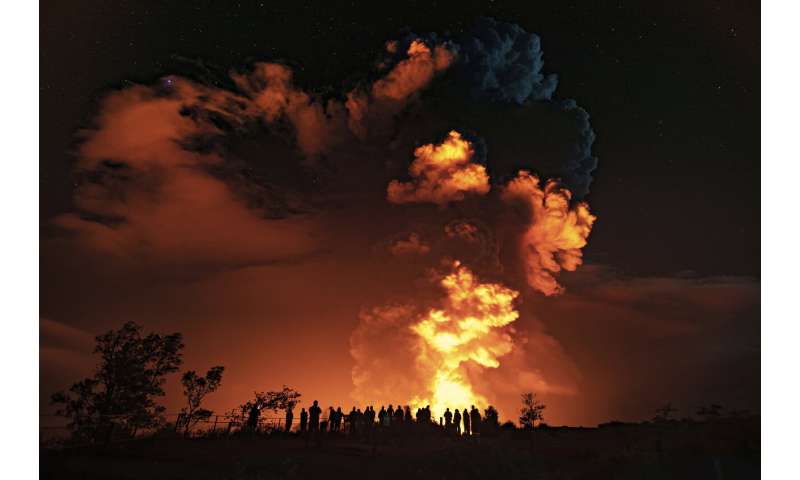PELE CELEBRATES SOLSTICE
UPDATELava lake forms as Hawaii volcano erupts after
2-year break
by Audrey McAvoy



by Audrey McAvoy

A plume rises near active fissures in the crater of Hawaii's Kilauea volcano on Monday, Dec. 21, 2020. People are lining up to try to get a look at the volcano on the Big Island, which erupted last night and spewed ash and steam into the atmosphere. A spokeswoman for Hawaii Volcanoes National Park says the volcanic activity is a risk to people in the park Monday and that caution is needed. (M. Patrick/U.S. Geological Survey via AP)
Lava was rising more than 3 feet (1 meter) per hour in the deep crater of a Hawaii volcano that began erupting over the weekend after a two-year break, scientists said Tuesday.
Kilauea volcano within Hawaii Volcanoes National Park on the Big Island was gushing molten rock from at least two vents inside its summit crater, the U.S. Geological Survey said. A lava lake has formed, rising about 440 feet (134 meters) from the bottom of the crater.
Since the eruption began Sunday night, Kilauea has spewed some 2 billion gallons of lava (10 million cubic meters), enough to cover 33 acres (13 hectares). The lava has been contained inside the deep crater.
It isn't threatening to get close to people or cover property, like when Kilauea erupted from vents in the middle of a residential neighborhood in 2018 and destroyed more than 700 homes.
Still, the Hawaiian Volcano Observatory has warned residents to beware of potentially high levels of volcanic gas, rockfalls and explosions.
When erupting, Kilauea tends to spew large volumes of sulfur dioxide, which forms volcanic smog, or vog, when it mixes with oxygen, sunlight and other gases in the air. The state Department of Health warned residents to reduce their outdoor activities if they encounter volcanic smog conditions.
Kilauea is one of the world's most active volcanoes, having erupted some 50 times in the last century. Between 1983 and 2018, it erupted almost continuously. It had a lava lake in its crater for the last decade of that eruption.

Lava was rising more than 3 feet (1 meter) per hour in the deep crater of a Hawaii volcano that began erupting over the weekend after a two-year break, scientists said Tuesday.
Kilauea volcano within Hawaii Volcanoes National Park on the Big Island was gushing molten rock from at least two vents inside its summit crater, the U.S. Geological Survey said. A lava lake has formed, rising about 440 feet (134 meters) from the bottom of the crater.
Since the eruption began Sunday night, Kilauea has spewed some 2 billion gallons of lava (10 million cubic meters), enough to cover 33 acres (13 hectares). The lava has been contained inside the deep crater.
It isn't threatening to get close to people or cover property, like when Kilauea erupted from vents in the middle of a residential neighborhood in 2018 and destroyed more than 700 homes.
Still, the Hawaiian Volcano Observatory has warned residents to beware of potentially high levels of volcanic gas, rockfalls and explosions.
When erupting, Kilauea tends to spew large volumes of sulfur dioxide, which forms volcanic smog, or vog, when it mixes with oxygen, sunlight and other gases in the air. The state Department of Health warned residents to reduce their outdoor activities if they encounter volcanic smog conditions.
Kilauea is one of the world's most active volcanoes, having erupted some 50 times in the last century. Between 1983 and 2018, it erupted almost continuously. It had a lava lake in its crater for the last decade of that eruption.

In this photo provided by the National Park Service, people watch an eruption from Hawaii's Kilauea volcano on the Big Island on Sunday, Dec. 20, 2020. The volcano shot steam and an ash cloud into the atmosphere which lasted about an hour, an official with the National Weather Service said early Monday, Dec. 21, 2020. (Janice Wei/National Park Service via AP)

A plume rises near active fissures in the crater of Hawaii's Kilauea volcano on Monday, Dec. 21, 2020. People are lining up to try to get a look at the volcano on the Big Island, which erupted last night and spewed ash and steam into the atmosphere. A spokeswoman for Hawaii Volcanoes National Park says the volcanic activity is a risk to people in the park Monday and that caution is needed. (M. Patrick/U.S. Geological Survey via AP)

In this photo provided by the U.S. Geological Survey, lava flows within the Halema'uma'u crater of the Kilauea volcano Sunday, Dec. 20, 2020. The Kilauea volcano on Hawaii's Big Island has erupted, the U.S. Geological Survey said. (U.S. Geological Survey via AP)
Explore further Volcano erupts on Hawaii's Big Island, draws crowds to park
© 2020 The Associated Press.
Explore further Volcano erupts on Hawaii's Big Island, draws crowds to park
© 2020 The Associated Press.
Volcanic eruption boils off massive lake
For months, Hawaii's Kilauea volcano site had been home to a deadly water lake. The lake was over 130 feet deep with a volume equivalent to almost 200 Olympic swimming pools. It showed temperature reading as high as 185 degrees Fahrenheit. For reference, water 154 degrees Fahrenheit or higher can scald humans instantaneously. However, that lake's life came to an abrupt end as the volcano started erupting on December 20. Lava began flowing from three fissure vents inside the crater. The lava cascaded into the summit water lake and in no time, boiled off the water. The water lake is now gone and a new lake made up of lava sits at the base of the crater.
No comments:
Post a Comment